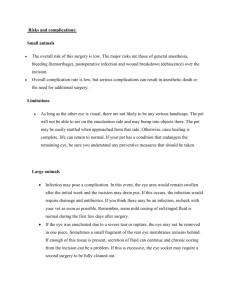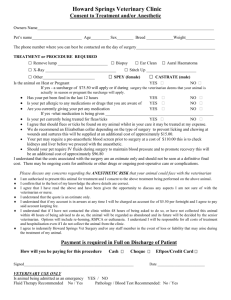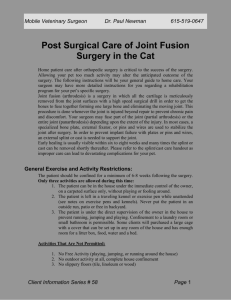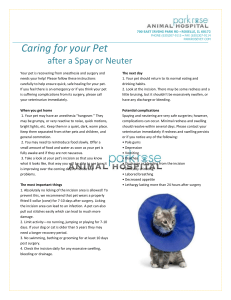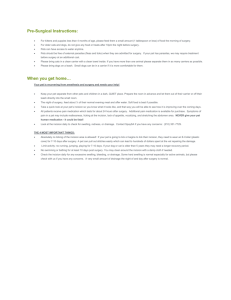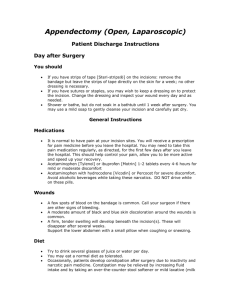Complications
advertisement
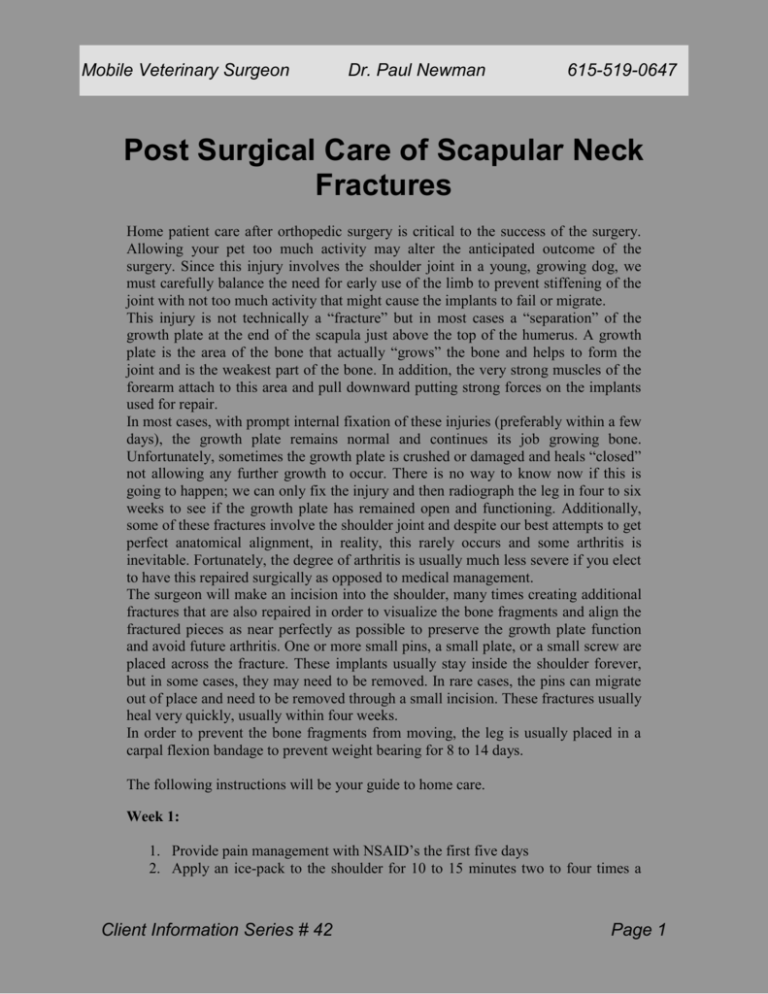
Mobile Veterinary Surgeon Dr. Paul Newman 615-519-0647 Post Surgical Care of Scapular Neck Fractures Home patient care after orthopedic surgery is critical to the success of the surgery. Allowing your pet too much activity may alter the anticipated outcome of the surgery. Since this injury involves the shoulder joint in a young, growing dog, we must carefully balance the need for early use of the limb to prevent stiffening of the joint with not too much activity that might cause the implants to fail or migrate. This injury is not technically a “fracture” but in most cases a “separation” of the growth plate at the end of the scapula just above the top of the humerus. A growth plate is the area of the bone that actually “grows” the bone and helps to form the joint and is the weakest part of the bone. In addition, the very strong muscles of the forearm attach to this area and pull downward putting strong forces on the implants used for repair. In most cases, with prompt internal fixation of these injuries (preferably within a few days), the growth plate remains normal and continues its job growing bone. Unfortunately, sometimes the growth plate is crushed or damaged and heals “closed” not allowing any further growth to occur. There is no way to know now if this is going to happen; we can only fix the injury and then radiograph the leg in four to six weeks to see if the growth plate has remained open and functioning. Additionally, some of these fractures involve the shoulder joint and despite our best attempts to get perfect anatomical alignment, in reality, this rarely occurs and some arthritis is inevitable. Fortunately, the degree of arthritis is usually much less severe if you elect to have this repaired surgically as opposed to medical management. The surgeon will make an incision into the shoulder, many times creating additional fractures that are also repaired in order to visualize the bone fragments and align the fractured pieces as near perfectly as possible to preserve the growth plate function and avoid future arthritis. One or more small pins, a small plate, or a small screw are placed across the fracture. These implants usually stay inside the shoulder forever, but in some cases, they may need to be removed. In rare cases, the pins can migrate out of place and need to be removed through a small incision. These fractures usually heal very quickly, usually within four weeks. In order to prevent the bone fragments from moving, the leg is usually placed in a carpal flexion bandage to prevent weight bearing for 8 to 14 days. The following instructions will be your guide to home care. Week 1: 1. Provide pain management with NSAID’s the first five days 2. Apply an ice-pack to the shoulder for 10 to 15 minutes two to four times a Client Information Series # 42 Page 1 Mobile Veterinary Surgeon Dr. Paul Newman 615-519-0647 day for the first 24 to 36 hours after surgery 3. If inflammation has resolved after 72 hours, apply a hot-pack to the shoulder for 10 to 15 minutes two or three times a day 4. Perform passive range of motion exercise (gently flex and extend the shoulder); 10 slow repetitions three times a day 5. Precede and follow the passive range of motion exercise with massage of the leg muscles (large muscles above the elbow) 6. Schedule a recheck with your doctor 1 week after surgery to evaluate range of motion, the incision and the bandage. Week 2: 1. Apply a hot pack to the shoulder for 10 to 15 minutes two or three times a day until the swelling has resolved 2. Continue massage 3. Schedule a recheck with your doctor 2 weeks after surgery to remove any sutures, the carpal flexion bandage, and evaluate range of motion. Week 3: 1. Begin slow leash walks to 10 to 20 minutes two or three times daily 2. Recheck 3 weeks after surgery if your pet is not using the leg or improving week to week. Weeks 4: At this point, your pet’s healing should be complete and should gradually return to full activity by the end of 6 weeks. It is highly recommended that you take your pet in four weeks after surgery to have a final radiograph to evaluate healing and the growth plate function. Additional Instructions: 1. Licking at the incision should be discouraged because it may lead to chewing at the sutures or staples causing a wound infection. It may be necessary to bandage the leg or use an Elizabethan collar to prevent licking. 2. Bandages, if used, should always be kept dry and clean. Any odors and/or persistent licking are indicators that there may be a potential problem and should be checked by your veterinarian immediately. Bandages and splints should be checked weekly by your veterinarian or veterinary technician. 3. Feed your pet its regular diet but reduce it by 10% to allow for reduced activity. 4. Mild swelling may occur near incision or low on limbs. Your veterinarian Client Information Series # 42 Page 2 Mobile Veterinary Surgeon Dr. Paul Newman 615-519-0647 should check moderate or severe swelling immediately. 5. Use of a joint protective supplement with glucosamine and chondroitin is highly recommended for at least six months to prevent any arthritis from forming in the joint. Complications As with any surgical procedure, complications can occur. Unlike human patients who can use a sling or crutches, our patients do not know enough to stay off a healing leg so restricted activity is a major responsibility of you, the pet owner. Failure to follow these instructions carefully can lead to delayed healing or even failure of the implants. There are important nerves surrounding the neck of the scapula and these can be damaged either by the inciting trauma, the sharp bone fragments, or inadvertent manipulation during surgery while reducing the fracture. While most nerve damage is temporary, permanent damage can result in muscle atrophy and diminished limb use. Despite our best efforts to obtain perfect anatomical alignment, in most cases some degenerative joint disease (arthritis) is to be expected. With early fixation, though, the prognosis for normal function is very good. The most common complication is delayed healing, where, despite our best efforts to stabilize the bone, individual patients respond slower than others. Occasionally, your pet may develop a small pocket of fluid called a seroma, around the metal implants we use. See your veterinarian if this swelling is larger than a grape. If you have any questions, please feel free to ask your veterinarian or call me at the number above. Follow Up Instructions: _____ Carpal flexion bandage placed post-operatively to be removed/rechecked in ____ days _____ Sutures/staples to be removed in two weeks _____ Start antibiotic tonight/tomorrow _____ Start pain medication tonight/tomorrow _____ Start joint supplement tonight/tomorrow Client Information Series # 42 Page 3
